Historical Wide Screen Gathering |
This article first appeared in |
| Written & photographed by: Thomas Hauerslev | Issue 50 - September 1997 |
 Historical Wide Screen Gathering
Left to right are: Thomas Hauerslev,
Willem Bouwmeester, Walter Siegmund, John Davis, Brian O'Brien, Jr. og
Robert Throop Historical Wide Screen Gathering
Left to right are: Thomas Hauerslev,
Willem Bouwmeester, Walter Siegmund, John Davis, Brian O'Brien, Jr. og
Robert ThroopFollowing four days of successful Cinerama excitement in Dayton, Ohio, US, including a cocktail party and screening of the film "Cinerama Holiday" for the cast and crew, the Trollers and the Marches, Louis de Rochemont, III, Borden Mace and Waring Jones, my travel companion, Willem Bouwmeester and I arrived in Bradley Airport, north of Hartford, Connecticut. The next four days would be centered around the people behind the Todd-AO process. I had corresponded with Mr. Brian O'Brien, Jr. since 1993 and now we were going to meet. |
Further in 70mm reading:
|
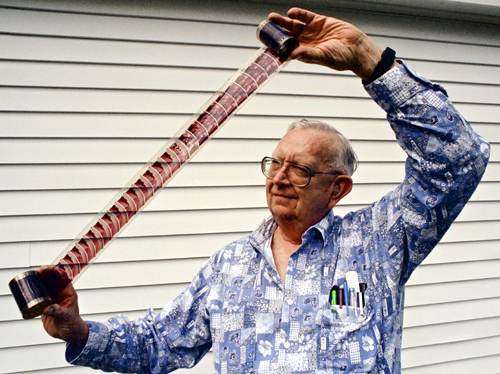 Brian
O'Brien, Jr. with a piece of distortion corrected 70mm film from "Around the World in 80
Days" Brian
O'Brien, Jr. with a piece of distortion corrected 70mm film from "Around the World in 80
Days"10 minutes past 12 PM Mr. O'Brien, Jr. picked us up in the airport. I recognized him immediately from pictures although he carried a cardboard sign with my name on it. After an openhearted welcome we drove off to our Wintergreen Bed and Breakfast. The B&B was going to be our home the next few days. As guest of Mr. O'Brien we stayed near Woodstock. A small town in the north eastern corner of beautiful Connecticut. The sun was shining from a blue sky and the countryside looked very much like Denmark to me. I felt quite comfortable. Along the highway I asked Mr. O'Brien a question which I had wondered about for years. Did his father [Dr. Brian O'Brien] make a camera capable of taking 10.000.000 pictures per second, or was it an editorial error? The answer was positive. The camera, however, was a special camera developed to take 1 single picture of an A-bomb during the blast to measure the power. Later on Mr. O'Brien showed us some footage samples of the Bikini A-bomb test. |
|
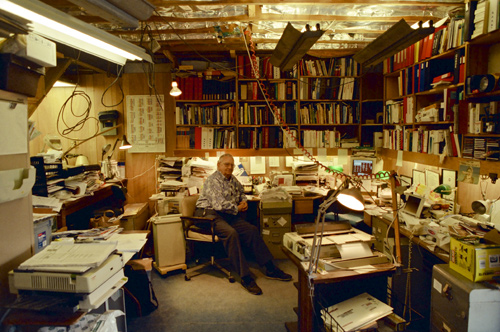 Brian
O'Brien, Jr. in his international head quarter. Brian
O'Brien, Jr. in his international head quarter.Later the same evening, after we settled in at the B&B, Dr. Walter Siegmund and his wife Lois Siegmund picked us up and drove us to Mr. O'Brien's house for drinks and an official welcome. That evening we were joined by Bob Throop, cinema field service engineer in the Buffalo, Rochester and Vernon area who I knew and had invited along for the occasion. It was thrilling to meet the people who actually engineered the Todd-AO system 40+ years ago. Mr. Henry Cole who worked with the camera had taken ill with the flu and was unable to join us. After drinks we drove to the nearby village and had dinner at the Vine Bistro. I explained my plans of interviewing Mr. O'Brien and Mr. Siegmund the next few days. I had prepared a list of questions to work from. As the evening proceeded, many vivid memories about Michael Todd, American Optical Company, Fred Zinnemann, Dr. Brian O'Brien and Rodgers and Hammerstein were told. With my background as a projectionist I have studied the Todd-AO history for the past 15 years. This was a fascinating climax. In 1953 Mr. O'Brien and Mr. Siegmund were in their late twenties when this adventure began. Today both of them refer to this period of their lives, from 1953 to 1957, as the most exiting. It is easy to understand why. |
|
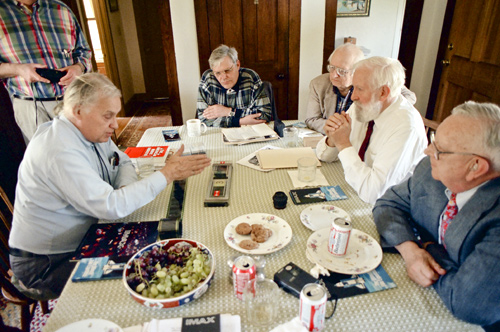 Cinerama,
Todd-AO and IMAX around the table. Left
to right: Bill Shaw (IMAX), Willem Bouwmeester (IMAX), Dick Babish
(Cinerama), Walter Siegmund (Todd-AO)and Brian O'Brien, Jr. (Todd-AO). Cinerama,
Todd-AO and IMAX around the table. Left
to right: Bill Shaw (IMAX), Willem Bouwmeester (IMAX), Dick Babish
(Cinerama), Walter Siegmund (Todd-AO)and Brian O'Brien, Jr. (Todd-AO).The following day we met at Mr. Sigmund's house at 10 AM. We arrived almost simultaneously with Mr. O'Brien. The sun was shining and this day was going to be memorable for everybody. Mr. Siegmund greeted us welcome with a big smile. Another Todd-AO engineer, Mr. John Davis, who was responsible for the optical computing facility at AO, was there too. |
|
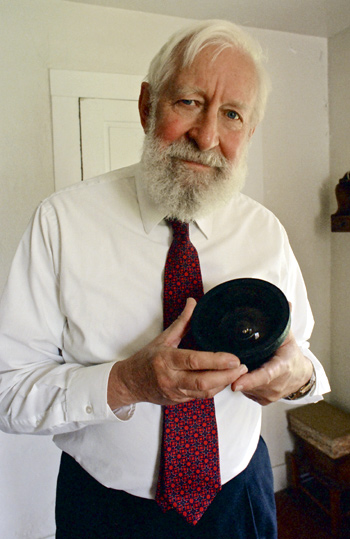 Walter
Siegmund and the Todd-AO Baby Bug eye made for 35mm film Walter
Siegmund and the Todd-AO Baby Bug eye made for 35mm filmBefore leaving Europe, Willem had contacted Mr. Richard C. Babish and Mr. William C. Shaw and invited them to come on this day too. Mr. Babish was responsible for the first Cinerama camera. He worked closely with Fred Waller to construct the 3-strip camera for him. Later on he worked on the Cinemiracle camera and how to get around the Cinerama patents. Mr. Shaw is responsible for the IMAX Rolling Loop projector. He is one of the 5 gentlemen who founded IMAX Corporation in Canada. During the day Mr. Babish and Mr. Shaw arrived at Mr. Sigmund's house. From my list of questions I began to ask Mr. O´Brien and Mr. Siegmund when they first became involved with American Optical [AO] Company. My interest was to establish when Michael Todd and Dr. O'Brien first met in Rochester to discuss if the 3-projector Cinerama process might be duplicated with one projector. That particular piece of information is hard to tie down. Mr. O'Brien said Mike [Todd] phoned his dad every night for at least three weeks. LIFE magazine wrote that Mike Todd spent a couple of weeks looking for "The Einstein of the optical racket" until he finally found Dr. O'Brien in October 1952. |
|
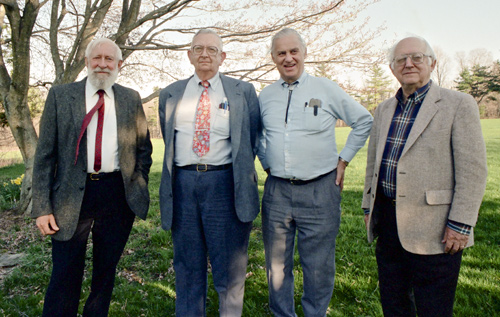 Engineers
of large format motion picture systems. Left
to right: Walter Siegmund & Brian O'Brien, Jr. of Todd-AO, Bill Shaw of
IMAX and Dick Babish of Cinerama. Engineers
of large format motion picture systems. Left
to right: Walter Siegmund & Brian O'Brien, Jr. of Todd-AO, Bill Shaw of
IMAX and Dick Babish of Cinerama.After the meeting Mr. Siegmund, a student of Dr. O'Brien's, was sent to New York by Dr. O'Brien to investigate Cinerama. To this day Mr. Siegmund still has his notes in which he wrote light measurements and the layout of the 3-projector setup at the Broadway Theatre. Unfortunately his notes did not carry any dates. Another Todd-AO ingredient was a printer that made specially curved prints by optical correction. Three generations of the printer were made. The Mark I was made by American Optical primarily to prove it could be done. Mark II was used to make tests and Mark III, the fastest, was installed in New Jersey to make "Oklahoma!" 70mm prints. Mr. O'Brien and Mr. Siegmund told us about the various stages of the printer, the problems involved, and how, after American Optical withdrew from Todd-AO in 1957/58, the printers were scrapped. |
|
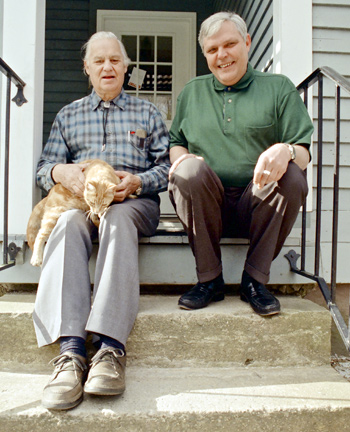 Bill
Shaw and Willem Bouwmeester Bill
Shaw and Willem BouwmeesterOne particular detail Mr. O'Brien told us was the Mark III printer was a continuous printer, not a step printer as generally believed. A detail both gentlemen were proud of. As the meeting proceeded I kept taking notes while asking questions. Just after 12 o'clock Mr. Babish and his wife arrived from New York. And from Canada came Mr. Shaw and his wife Barbara. The circle was full. Around the table were key personnel from three major large format systems from the history of movies; Cinerama, Todd-AO and IMAX. None of these gentlemen had ever met before. All experts in their separate fields now sharing technology, history and anecdotes of big screen innovations. Everybody had brought their own amount of documentation and put it on the table. Among stills, brochures, film clips and various lenses were tape recorders, liquid refreshments, grapes and crackers. |
|
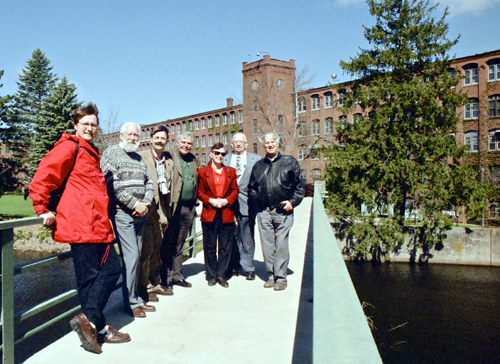 Visiting
American Optical Company in Southbridge. Left to right: Thomas Hauerslev,
Walter Siegmund, Dick Whitney, Willem Bouwmeester, Mrs. Shaw, Brian O'Brien,
Jr. and Bill Shaw Visiting
American Optical Company in Southbridge. Left to right: Thomas Hauerslev,
Walter Siegmund, Dick Whitney, Willem Bouwmeester, Mrs. Shaw, Brian O'Brien,
Jr. and Bill ShawAt some point Mr. Sigmund's wife Lois Siegmund announced that lunch was ready in the kitchen. We all took a break to have some bread, salad and beer. The sun was still shining and the ritual amount of pictures of the guests were taken outside on the patio. Everybody had brought their camera for this unique occasion. Mr. Shaw continued after lunch by explaining the principle of The Rolling Loop used in the IMAX projector. He had brought a model with him to illustrate how the system works. His original plan had been bring an 15-perf IMAX camera, but fear of troubles with the US customs kept the camera in Canada. The rolling loop principle was invented by Ron Jones in Australia during a traffic jam nearly 30 years ago. The prototype was built the same evening and it exists to this day. The system has been used in a vertical version with 35mm film in Australia. The first IMAX camera was built by Norwegian Jan Jacobsen during a stay in Copenhagen. Camera #1 still exists and will be used in a future IMAX museum in Canada. |
|
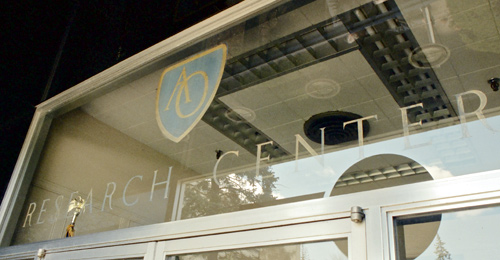 We spent the whole afternoon talking about movies. After dinner in
Sturbridge near Southbridge, Mr. Shaw continued with a fascinating 90 minute
slide show about the history of IMAX. It was well past midnight before the
day ended. Everybody was tired and yet I felt we could have continued
talking about this subject for hours. Mr. Throop went home to Vernon and the
rest of us went back to our B&B. I didn't get to bed until 3 in the
morning - I had some notes to write and some thinking to do. We spent the whole afternoon talking about movies. After dinner in
Sturbridge near Southbridge, Mr. Shaw continued with a fascinating 90 minute
slide show about the history of IMAX. It was well past midnight before the
day ended. Everybody was tired and yet I felt we could have continued
talking about this subject for hours. Mr. Throop went home to Vernon and the
rest of us went back to our B&B. I didn't get to bed until 3 in the
morning - I had some notes to write and some thinking to do.The following day, refreshed from a good nights sleep, Willem and I went to Mr. O'Brien's house. I still had some unanswered questions about Todd-AO which I hoped Mr. O'Brien could answer. Mr. O'Brien showed us around his house and we had some fine beer and pizzas for lunch. I managed to get additional valuable information on tape. Mr. O'Brien is a very kind man and is, like Mr. Siegmund, very proud of what they did at American Optical so many years ago. Later on, the Shaws joined us. The Shaws had been in Sturbridge that morning and seen the historical sights. That evening Willem and I invited Mr. O'Brien, the Siegmunds and the Shaws to dinner. The next day would be very busy. In the morning we were all going to visit the original scene of the crime: American Optical Company in Southbridge in Massachusetts. Mr. Siegmund and Mr. O'Brien left the company in 1957 and with only one recent exception, they had not been back since. After the visit to AO we would all go to Norwalk, CT to see the IMAX theatre. Mr. O'Brien and Mr. Siegmund had never seen an IMAX theater before. |
|
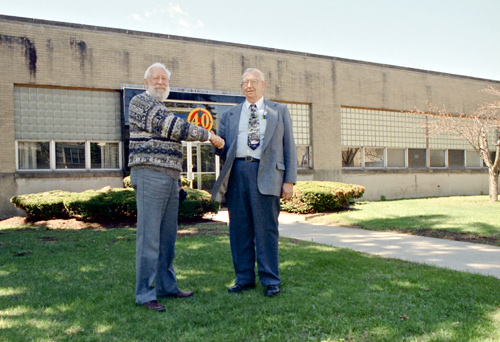 Walter
Siegmund and Brian O'Brien, Jr. in front of the American
Optical Company Research Building where the Todd-AO process was developed. Walter
Siegmund and Brian O'Brien, Jr. in front of the American
Optical Company Research Building where the Todd-AO process was developed.18 months earlier I had contacted AO and received an invitation from Mr. Dick Whitney, Manager of Ophthalmic Lens Design & Optical Technology. Mr. Whitney had arranged for us to see all the original places of events at American Optical Company on May 2, 1997. Mr. Whitney showed us a map of AO from the fifties with the location of the various offices and shops. AO used to be a very large factory with thousands of employees. Today much of it is closed and moved to Mexico where the glass is now made because salaries are lower. The glass is shipped from Mexico to Southbridge and re-manufactured. Much of the area now belongs to the city and much of the former AO facilities are used for other purposes. |
|
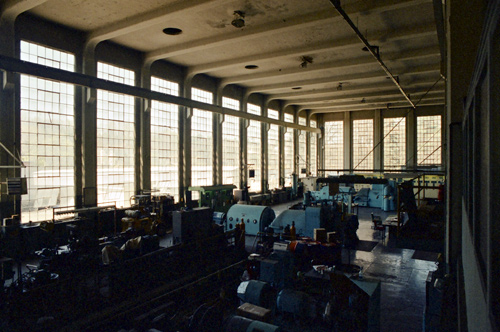 The
interior of the American Optical Company's power house where the first large
scale Todd-AO tests took place. The
interior of the American Optical Company's power house where the first large
scale Todd-AO tests took place.Mr. O'Brien, Mr. Siegmund and Mr. Whitney were our tour guides for the day and we began at the AO museum located in the main building. Unfortunately there was nothing on display about the Todd-AO process. They do have a huge collection of interesting stills of the factory, thousands of spectacles (glasses) and other American Optical products. After the museum and a short peek inside of what used to be the offices of Dr. O'Brien and Mr. Stewart, we continued to the Research Building. The first Todd-AO camera, lenses, screens and a small test screening cinema were built here. In the office that used to be Walter Sigmund's, a young man was sitting. He was quite amazed by the visit. He had never heard about Todd-AO but he did recognize the name Brian O'Brien. He was even more amazed to shake hands with Brian O'Brien, Jr. We saw every room in the house and Mr. Siegmund pointed out where the small cinema had been. Mr. Whitney took us to see the power house. The Power House is a very large building quite suitable for a Todd-AO cinema. It is tall, long and wide. And that is exactly what it was used for. In one end of the building an old ex-Paramount 65mm Ernemann projector was set up on a scaffold. In the opposite end a 50 feet curved screen was installed. Every night for months and months, after 8:00 PM Mr. Siegmund remembered, he ran Todd-AO tests in the power house. |
|
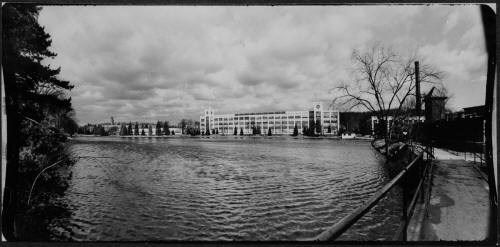 Black
and white 65mm
Todd-AO
frame from
1953
with distortion correction with zero droop. The view of American Optical
Company
across the lake in Southbridge, Massachusetts, USA. The American Optical Research
building is seen to the left of the big building. Black
and white 65mm
Todd-AO
frame from
1953
with distortion correction with zero droop. The view of American Optical
Company
across the lake in Southbridge, Massachusetts, USA. The American Optical Research
building is seen to the left of the big building.The front cover of the 1953 AO annual report has a still photograph of the lake and the AO research building taken with the 128º lens. We found the same spot and took a few pictures of the same view which concluded the tour and a fascinating morning. The visit at AO had come to an end and we had a 3 hour drive to Norwalk in front of us. We thanked Mr. Whitney for his kindness and for letting us see AO. 3 hours later we were at The Maritime Aquarium at Norwalk. Mr. Shaw had arranged to see the film and a visit to the projection room. Mr. Babbish joined us in Norwalk. The IMAX film was "Whales". Mr. O'Brien and Mr. Siegmund gazed at the tall screen and were both impressed by it. After the show Willem and Mr. Shaw explained the mechanics of the IMAX projector in great detail to Mr. O'Brien, Mr. Siegmund and Mr. Babish. They all nearly fell into the projector in pure excitement. It was clear they all enjoyed to see and understand how things work. The local projectionist asked us to close the doors after we departed, as he was in a hurry and had to leave. When he found out who the guests were, he probably did not worry about his projector. |
|
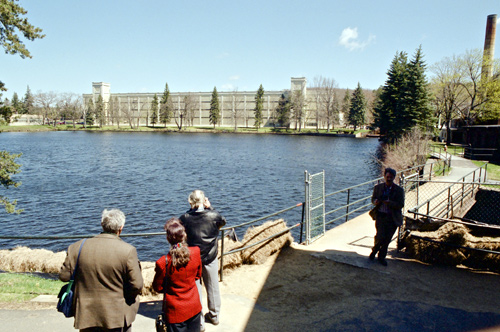 The
same spot in 1997 of American Optical Company
across the lake in Southbridge. The
same spot in 1997 of American Optical Company
across the lake in Southbridge.The long, exciting and memorable day had come to an end. The visit with Mr. O'Brien and Mr. Siegmund had also, sadly, come to an end. We all said goodbye and shook hands. It was a moving moment as I felt we were only just getting started. Brian O'Brien, Walter and Lois Siegmund went home to Connecticut. The Shaws went home to Canada and Mr. Babish drove us to the train. Two days later we were going to see Dick Babish again in New York. But that is a completely different story. To be continued in the next issue. I will take you to Oyster Bay on Long Island and show you pictures of the original Cinerama HQ and the in-door tennis court where everything started. |
|
| Go: back
- top - back issues Updated 22-01-25 |
